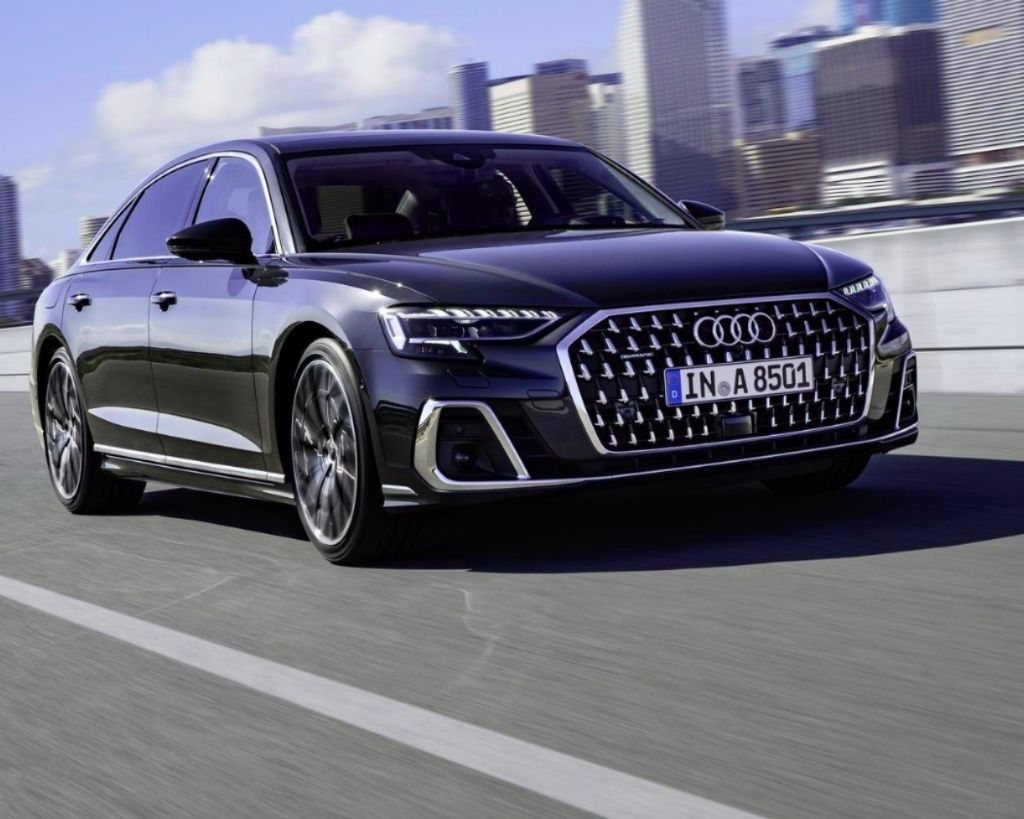
For the A8 facelift, Audi also polished the Digital Matrix Light, which debuted in the E-Tron Sportback. The matrix projector in the LED headlights can not only hide other road users in a targeted manner, but it can also trace the lanes. We were able to try out the Digital Matrix Light (DML) live. But Showtime is also in the state.
The revised A8 of the 2022 model year can, if desired, cast animated light graphics onto the street in front of it or onto the garage wall.
They demonstrate pretty well how the LED headlights work with the matrix projector – they work in a similar way to a projector but have to produce the videos themselves. The core of the technology is a chip the size of a postage stamp from Texas Instruments, on which 1.3 million small mirrors change their direction of reflection under piezoelectric control. And that 5,000 times a second.
If you direct the light coming from a vital LED source into an absorber instead of into the lens, dark areas will appear in the image on the street. The whole thing is controlled by a central computer integrated into the unit for the assistance systems. They also provide information about road markings, other road users’ distances, or speed. The rear lights of the Audi A8s have also been able to order different signatures since the facelift. When the vehicle is stationary, the rear lights switch to full brightness if a car approaches from behind within less than 2 meters.
Also Read: Infrastructure: Inductive Charging With Individual Performance
Test Drive With Audi’s DML In The E-Tron Sportback (November 2019)
In November at 4:45 am, even in California’s metropolis Los Angeles, there is no trace of the sun. Roads that are wet in some areas show that this day should bring less light even after sunrise – it rained.
Stephan Berlitz, Head of Lighting Innovations at Audi, has his forehead wrinkled for a moment: “Wetness reflects light, the effect is less noticeable,” he says regretfully when we arrive at an unattractive parking lot at around 5:00 am, 10 minutes from downtown. The new Digital Matrix Light from Audi is supposed to show the “effect” in the E-Tron Sportback while driving on the highway at night. Given the single-digit temperatures and the night is drawing to a close, we quickly get into the fully electric SUV coupe, which is currently celebrating its world premiere at the Los Angeles Auto Show and which is already standard on the inside, without looking particularly at the front from the interior of the normal E-Tron to distinguish.
Light Guidelines
Berlitz routinely steers the e-car, moving quietly and quickly out of town. As soon as the cameras of the assistance systems detect lane markings, a discreet but recognizable carpet of light shines ten meters in front of the car, which is miraculously always as wide as the lane and even traces the curves. In it, two-line dark arrows, whose shape is reminiscent of the brand logo of the Californian mineral oil company Chevron, mark the width of the E-Tron, including its exterior camera mirrors.
Berlitz has no trouble following the carpet of light at the wheel. From the front passenger seat, it is easy to see that the lighting is a much more pleasant lane departure warning system than conventional systems with steering impulses, warning tones, or shaking. Of course, only at night. During the day, the carpet of light is too weak and invisible.
No Glare, No Distraction For Others
Stephan Berlitz once directed the chevron stripes to the right edge of our lane to demonstrate how exactly the dimensions correspond to the edges of the arrows. The truck driver next to us has noticed our approach and steers his truck a little to the right within its lane. The light field ends about 60 meters in front of us. It anticipates a lane change on our part and already spreads to the neighboring street to then withdraw harmoniously from the previously traveled lane: a unique but intuitively understandable effect.
If a vehicle in front of us changes to our lane at a shorter distance, the light field shortens at lightning speed so that it always ends below the bumper of the vehicle in front. He shouldn’t even perceive the play of light. Only the occupants of the E-Tron should use them without distracting or even irritating other road users. As Berlitz proudly explains, this was particularly important to the registration authorities and has succeeded without reservation.
Integrated Pedestrian Detection
However, the approval is still missing for the USA of all places. Granting them is not ruled out, but in general, the traffic legislation in the USA, especially when it comes to light, comes from the 1960s. In general, the US authorities would be very skeptical if you told them that you wanted to simulate road markings – after all, that was one of the tasks of the road operator. In addition, they placed little value on good car lights. Most vehicles here still have classic halogen headlights, while a lot has happened in Europe in this regard in recent years.
According to Berlitz, the effect is recognizable: In the USA, the proportion of fatal accidents in the dark has remained practically the same, while in Europe, it has fallen significantly.
Audis DML also brings more safety through good illumination, fading out oncoming traffic from the cone of the high beam and even from pedestrians. DML can mark this around ankle height with targeted light points without dazzling. Nevertheless, this helps the driver not to overlook pedestrians nearby. Fortunately, nobody is walking on the highway, so we cannot try out the function this morning.
Games Of Light For Entertainment
The entertaining features of the DML, on the other hand, do. To do this, Stefan Berlitz heads for another parking lot. After pressing the start/stop button, the LEDs project animated graphics and the Audi e-Tron logo onto the opposite wall. If they don’t exist, the play of light on the asphalt in front of the E-Tron can be admired; in tight parking spaces, they could be displayed somewhat distorted on the rear of the vehicle in front of them; Stefan Berlitz has something to do with bright Audi lettering on cars from competing brands. What kind of animations the E-Tron plays when greeting or saying goodbye can be selected in the infotainment settings menu.
The animations have been used since mid-2020 to build E-Tron buyers who are willing to pay 4,500 euros for it. With the A8, the “digital matrix light” surcharge is 1,820 euros because the HD matrix LED headlights are part of the standard equipment – like the digital OLED rear light. Given the high absolute prices in the luxury class, the extra euros should be bearable, and the DML share could rise accordingly.
CONCLUSION
Compared to the technical effort and the price, the safety gain thanks to Audi’s Digital Matrix Light (DML) may still appear small. The performance is impressive; the practical benefit is supporting the driver without nagging or annoying him. The light functions tend to help him drive more safely instead of pointing out (supposed) errors.
However, in the luxury class, the less valuable gimmicks and differentiation options could be a great incentive to buy. Why not? After all, given the LED technology, it hardly costs any energy.





